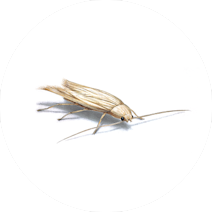Moth Facts & Information
Protect your home or business from moths by learning techniques for identification and control.
Order Lepidoptera
IDENTIFY
Types of Moths
What do moths look like?
Moths vary dramatically in appearance and size depending on the species. Some are massive and others tiny. Moths typically have two pairs of wings covered in scales, a coiled proboscis, and large compound eyes. Certain species of moths are brilliant with metallic colors while other are drab in browns or grey. Most indoor infesting moths are smaller than 2 cm wingspan and often are shades of grey or brown to reddish brown.
-

Almond Moth
Ephestia cautella
-

Angoumois Grain Moth
Sitrotroga cerealella
-

Buck Moth
Hemileuca maia
-

Cactus Moth
Cactoblastis Cactorum
-

Casemaking Clothes Moth
Tinea pellionella
Treatment
How do I get rid of moths?
What Orkin Does
Orkin Pros are trained to help manage moths and similar pests that invade homes. Since every yard or home is unique, your Orkin Pro will design a special moth treatment plan for your situation.
A moth treatment plan would include the following:
Inspection & Treatment Plan
Customer Education
Monitoring
Habitat Reduction & Non-Chemical Treatments
Insect Growth Regulators
Chemical Control
The use of common pesticides is not advised in treating a moth infestation. The most effective solution for indoor infesting moths is to identify the moth and the breeding materials. Once found, the breeding materials should be addressed according to the item.
Call us877-884-0491
FAQs
-
There are many different species of moths, but homeowners usually encounter clothes moths and pantry moths. These pests are attracted to a variety of household items, which they may use as a food source or a place to lay eggs.
Pantry moths, such as the Indian meal moth, eat dry goods, including grains, nuts, flours, spices, and chocolate. Clothes moths infest items like clothing and upholstery made of animal-based materials.
-
Moth signs depend greatly on the species. Indoors, moths are detected by the adults as they fly about the room or rest on surfaces. Fabric-feeding moths are detected when feeding damage to fabrics is discovered. Some will also leave webbing, cocoons and even droppings as evidence of their activity. Stored product moths may leave behind damaged food items, webbing and droppings as well. Some moths will leave their food source when it time to pupate. The pupae may be seen in corners of cabinets, drawers or walls.
Moths are capable of infesting a home long before their populations are noticed. As a result, substantial damage can occur to clothing or furnishings.
While some are harmless and others are known to be beneficial for their silk and nutritional value, most moths and caterpillars are considered nuisance pests. A few, including the Io moth, the saddleback caterpillar moth and the southern flannel moth, are more concerning because the larvae can sting. Particularly in agricultural communities, some moth and caterpillar populations cause severe damage.
Spongy moth caterpillars are known to damage forested areas in the northern United States.
Fruit farms suffer from codling moth infestations, while cabbages and mustard crops are often destroyed by the diamondback moth.
Some moth larvae are known to consume cotton, tomatoes and corn. These larvae are commonly referred to as cotton bollworms, tomato fruitworms and corn earworms. Some moth species are also known to eat fabrics made from natural fibers, such as wool and silk.
-
The extent of moth damage depends on the degree of infestation. A large population in the house can be quite costly. Clothes moth larvae leave behind holes in garments and feces stains as they feed, while large amounts of food may need to be thrown away due to contamination from pantry moth webbing, cocoons, and droppings.
Behavior, Diet & Habits
Understanding Moths
Behavior, Diet & Habits
Moth behavior, diet and habits are as varied as their appearance. They range from beautiful pollinators to sneaking blood feeders. Some moths are major agricultural pests, while the majority complete their life cycle with no significant direct impact on man. They often are the food source for many animals, including birds, mammals, reptiles, amphibians, insects, arachnids and even some plants. Indoors, homeowners most likely encounter moths that are either feeding on stored pantry items or on fabrics.
Damage Caused by Moths
Although they are most famous for their ability to ruin wool clothing, webbing clothes moths are also attracted to a variety of other natural materials, including silk, hair, felt, fur and feathers. These moths tend to measure 2.5 to 5 cm in length and are buff colored.Webbing clothes moth larvae, not the adults, are responsible for destroying clothing. They prefer animal-based fabrics. Moths may consume sweaters, coats, blankets, carpets, decorative items, comforters, pillows and toys. They prefer not to feed on synthetic fibers, but will consume blended and stained fabrics.
Where do they hide?
They avoid light and are most commonly found in dark locations such as basements, attics and closets. Within these locations, moths can be found in the folds of fabrics or hiding in corners.

